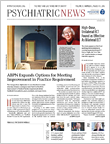Twice-weekly high-dose unilateral electroconvulsive therapy (ECT) appears to be no less effective than bitemporal ECT for depression and may be preferable because of its better cognitive side-effect profile, according to a report in the February 19 AJP in Advance.
Maria Semkovska, Ph.D., of the Department of Psychiatry at Trinity College Dublin and colleagues reported on the results of EFFECT-Dep (Enhancing the Effectiveness of Electroconvulsive Therapy in Severe Depression). The trial was a randomized, “non-inferiority” trial with a six-month follow-up to determine whether high-dose unilateral ECT was inferior to the more standard bitemporal ECT for severe depression in routine practice over six months.
One-hundred and thirty-eight participants were randomly assigned to bitemporal or high-dose unilateral ECT. Participants were inpatients recruited between May 2008 and October 2012 from St. Patrick’s Mental Health Services, an independent nonprofit organization that provides national services and runs Ireland’s largest ECT clinic
“Seizure threshold”—the minimum charge required to induce the generalized seizure needed for therapeutic effect—was established by dose titration at the first session, and subsequent treatments were 1.5 times this threshold for bitemporal ECT and six times this threshold for unilateral ECT. In line with regular practice, the number of ECT sessions was determined by referring clinicians in consultation with patients, with up to 12 sessions in accordance with recommendations of the Irish Mental Health Commission
The primary outcome was change in the 24-item Hamilton Rating Scale for Depression (HAM-D) score after the ECT course. A pre-specified range of a four-point difference in either direction was established as the range within which the treatment would be considered “non-inferior.”
Secondary depression outcomes included HAM-D scores at the three- and six-month follow-ups, end-of-treatment remission and response status, and relapse status for remitters during the six-month follow-up. Remission was defined as 60 percent or greater decrease from the baseline HAM-D score and a score of 10 or less for two consecutive weeks; response was defined as a 60 percent or more decrease from the baseline HAM-D score and a score of 16 or less; and relapse was defined as a HAM-D score of 16 or more for two consecutive weeks.
The researchers found that high-dose unilateral ECT was not inferior to bitemporal ECT on HAM-D scores, with a mean difference of 1.08 points in favor of unilateral ECT (within the range of “non-inferiority”). There were no significant differences for response and remission or six-month relapse status. Recovery of orientation was quicker following unilateral ECT, and bitemporal ECT was associated with a lower percent recall of autobiographical information.
The study appears as the Food and Drug Administration (FDA) is proposing to reclassify ECT from a Class III (high-risk) medical device to Class II (low-risk), a change APA supports. Comments on the proposal were due March 28.
Semkovska and colleagues say the AJP study has important clinical implications. “In terms of harms/benefits ratio, high-dose unilateral ECT was non-inferior to bitemporal ECT but showed a better cognitive profile, especially for preserving retrograde personal memories and fewer subjective cognitive side effects,” they wrote.
“While there is much interest in other modifications to maintain effectiveness but reduce side effects (such as ultra-brief pulse-width ECT), these require further refinement and characterization for optimization. Our findings justify considering high-dose unilateral ECT as the preferred ECT option for treating depression and may help improve acceptability and availability of this effective treatment.” ■
“Bitemporal Versus High-Dose Unilateral Twice-Weekly Electroconvulsive Therapy for Depression (EFFECT-Dep): A Pragmatic, Randomized, Non-Inferiority Trial” can be accessed
here.
